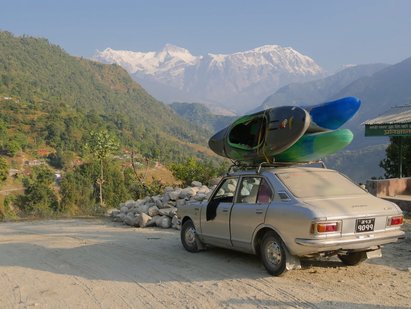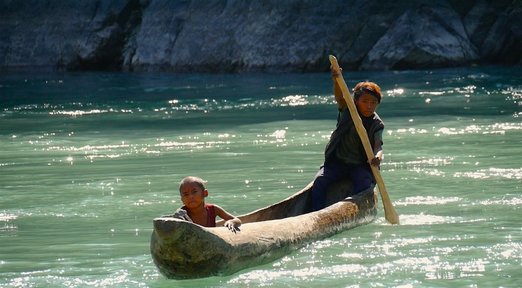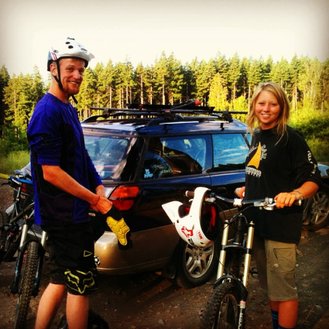By: Gerrit Egnew and Kirra Paulus
The moment when our boats first touched water – after seventy hours of travel – was intensely gratifying. This summer, noting that there was a dearth of data in Nepal, we sought to use our particular river skills to take water samples in places few people can go: the wild, frothing upper reaches of the rivers of Nepal.
Our water samples are well-traveled. They have moved hundreds of miles downriver by kayak and raft, transported across several countries in rig bags and backpacks, taken rides in rattling taxis, buses crammed with people, and multiple planes across nearly all of Nepal, circling the globe, before finally arriving in Maine. It’s funny, in a way, what it takes to move a liter of water from one particular place to another very specific place. Each water sample seems insignificant on its own, hardly worth the effort to isolate and transport it. But every sample is a small piece of data, each a sentence in a much bigger story of global microplastic pollution.
 En route to sample the turquoise waters of the Modi Khola by kayak. PC: Kirra Paulus
En route to sample the turquoise waters of the Modi Khola by kayak. PC: Kirra Paulus
The black and white lines of data don’t accurately convey the adventure it takes to collect it. “F-11252016-1” represents the frigid wade out into the Seti Karnali in the middle of the night. “F-11072016-1” brings back vivid memories of panic as the liter of water comes loose in my kayak and rattles around while I’m getting beaten down in a hole. It reminds me of the fear of losing a sample that we cannot retake, or of a place we’ll maybe never see again. The battered mango juice bottle “F-11272016-1” is from the dingy “tourist hotel” in Kharpatur, Nepal, where Kirra bravely ventured under the bed to kill the enormous spiders lying in wait. The numerous Karnali samples are the water bottles coated in road dust from a twenty-four hour bus ride, when we tried to sleep on the gear pile while soaring a foot into the air with every jolt. Some bottles are marked with colored string from the Madi Khola and Marsyandi because the Sharpie wore off during the clattering Jeep ride through an empty riverbed to the put in. Some bottles are clear, from high up on the Karnali or Modi Khola, taken from the feet of the Himalayan giants. Others are muddy, green-brown, taken from rivers swollen with runoff, tossing our tiny plastic boats high into the air, then deep and dark beneath the waves.
 Two village boys paddling over to check out our brightly colored plastic boats. PC: Kirra Paulus
Two village boys paddling over to check out our brightly colored plastic boats. PC: Kirra Paulus
Each sample we took was just that: one tiny piece of the global distribution of aqueous microplastics. But each bottle also contains a specific experience, tied to a place and time, unique and unrecoverable. This project changed how we viewed our travels; we took the time to peer behind the curtain of experiences presented to us. We examined more of the deeper societal, governmental, and cultural interactions and how they shape the complex interactions between the people and the environment of Nepal, ultimately affecting the distribution of microplastics across the country.
|
Kirra Paulus and Gerrit Egnew are part time students and full time adventurers, kayaking and skiing around both Montana and the globe. They spend their time alternately planning their next foray into the wilderness and eating snacks. Read more about their adventures on their blog.
|

